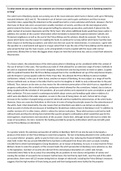To what extent do you agree that the extensive use of torture explains why the witch-hunt in Bamberg lasted for
so long?
The witch hunt of Bamberg stands out as being one of the most extensive witch hunts in history with up to 900 being
executed between 1623 and 32. The extensive use of torture was used to gain confessions and thus increase
conviction rates, supporting the statement as this would have led to a more extensive witch-hunt. However, the fact
that many of those who were accused were wealthy members of society, and thus not the stereotypical witch,
points towards the desire to seize their property fuelling the extensive persecution, particularly if placed into the
wider context of economic depression and the Thirty Years’ War where additional funds would have been useful. In
addition, the context of the counter-reformation which inevitably increased the suspicion between Catholic and
Protestant neighbours as well as the zeal of the Prince-Bishop and his advisors should be assessed. The criteria to
assess which factor was the reason for enabling the hunts to continue for so long will be which factor had the most
direct impact on furthering accusations, and which was the root cause for extensiveness. In conclusion, I agree with
the question to a small extent and agree to a larger extent that it was the role of the Prince-Bishop and his desire to
seize property that was the main reason, as his strong beliefs in hunts coupled with the issues with normal
governance allowed him to have the biggest direct impact on how the hunts were led, and as a result how extensive
they became.
To a lesser extent, the extensiveness of the witch persecutions in Bamberg can be considered within the context of
the use of torture in the cases. The Carolina Law Code of 1532 allowed for an extensive range of torture methods to
be used on suspected witches, such as the strappado, thumbscrews and forcing victims to kneel on spikes. Coupled
with the judicial freedom that the Prince Bishop enjoyed due to the constitutional set-up of the Holy Roman Empire,
and the Emperor’s preoccupation with the Thirty Years War, this allowed the Prince Bishop to extract multiple
confessions. Indeed, in the case of John Junius, another ex-mayor of Bamberg, he was subject to a range of horrific
torture methods and, as shown in the letter that he sent to his daughter in 1628, he only confessed due to the pain
inflicted. Thus, torture can be seen as a key reason for the extensive persecution of the witch-hunt as, regardless of
property confiscations, this is what led to the confessions which allowed for the convictions. Indeed, due to torture
being coupled with the schedule of 101 questions, all accused witches were expected to name accomplices as part of
their confession. This was rooted in contemporary beliefs about covens and hereditary guilt where relatives of a
witch were also likely to fall under suspicion, as seen in the case of Georg Hann. As such, torture led to a huge
increase in the number of people being accused of witchcraft and thus fuelled the extensiveness of the witch hunts.
However, there are some key limitations to this factor in terms of being the principle reason for the extensiveness of
the witch- hunt. Most importantly, the only reason that von Dornheim was able to use torture so extensively on
those accused of witchcraft was because of building the Drudenhaus (witch prison) in Bamberg in 1627 in addition to
smaller versions of it in other towns, which is where the torture took place. These witch-prisons could not be built
without funds and thus the driving force behind this was the property confiscations which would then pay for the
interrogations, imprisonment and executions of the accused. Clearly then, although torture did much to widen the
scope of accusations, its role is rooted in the funding provided by property confiscations which was led with great
zeal by Prince-Bishop von Dornheim.
To a greater extent, the extensive persecution of witches in Bamberg 1623-32 can also be seen to be largely a
product of the desire of the Prince-Bishop to seize their property. The law in Bamberg allowed for the confiscation of
an accused witches’ property, partly to pay for their own court costs, thus reducing the financial liability that the
state held. Under this law around 500,000 florins had been confiscated from those who were accused, including
100,000 florins which had belonged to Georg Neudecker, an ex-mayor of Bamberg. As such, it is clear that the Prince
Bishop’s desire to seize the property of the accused made the witch persecution in Bamberg more extensive as, due
to the legislation, members of society who did not fit the stereotypical description of a witch (old, female,
vulnerable) were likely to be accused, thus extending the accusations to new classes and genders of society and
causing the number of accused to be increased. Furthermore, the fact that by April 1631, near the end of the witch
persecutions, there were still 22 inmates being held on charges of witchcraft, including the Prince Bishop’s treasurer,
suggests that the high number of those being accused and their backgrounds were fuelled by the property





